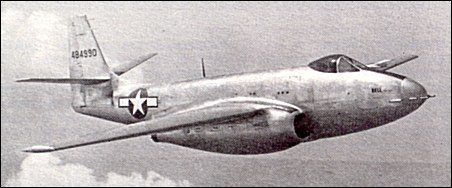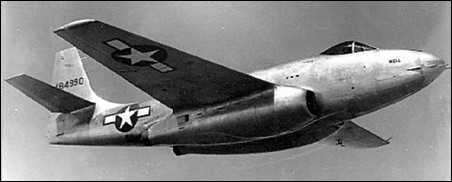 |
Bell XP-831945 |  |
| LONG-RANGE ESCORT FIGHTER | Virtual Aircraft Museum / USA / Bell |
 |
The XP-83 was the final contribution by the Bell firm to the US Air Force fighter series. On 24 March 1944, with the war in Europe signalling the need for a long-range escort fighter and the P-51 Mustang not yet proven in this role, the USAAF tasked the builder of the first American jet aircraft to build a larger, longer-legged jet fighter. Bell assigned engineer Charles Rhodes to 'bring along' the bulky XP-83, powered by two 1633kg thrust General Electric 1-40 (later J33-GE-5) turbojets. The craft was to be armed with six 12.7mm Browning nose machine-guns. First flown on 25 February 1945, the first XP-83 proved underpowered and unstable. The close proximity of the two low-slung powerplants caused hot exhaust gases to buckle the tail-plane unless, during run-ups, fire trucks were used to play streams of water over the rear fuselage! The second XP-83 was completed with a slightly different bubble canopy and extended nose to accommodate six 15.2mm guns, the increase in barrel diameter being based on anticipated firepower needs for the planned amphibious invasion of Japan. This airframe was used in gunnery tests at Wright Field, Ohio. Modified tailpipes, angled outwards, resolved the heat/buckling problem. Wind tunnel tests showed than an 45.7mm extension of the vertical tail would assure stability, though it is not clear whether this modification was actually made. Except with respect to range, which was a formidable 3540km with underwing drop-tanks, the Bell XP-83 seemed to offer no improvement over the Lockheed F-80 Shooting Star then in production. For the post-war fighter-escort role, the newly independent USAF turned to the North American F-82 Twin Mustang. The redesignated XF-83 soldiered on as a flying testbed for new technology. The first machine was assigned to a ramjet engine test programme. A hatch was cut in the belly to provide entry into the aft fuselage and an engineer's station, 'blind' except for a small port-side window, was created behind the pilot. Experimental ramjets were slung under the wings. The intent was for the XF-83 to serve as a proving vehicle for ramjet power, once aloft flying with the ramjets alone. In the later 1940s, similar tests were conducted with F-51s, F-80s and other types although no practical application was ever found. On 4 September 1947, just as this test programme had begun, a ramjet caught fire and flames spread to the wing. Pilot Chalmers 'Slick' Goodlin and engineer Charles Fay, without benefit of ejection seats, bailed out safely. The Bell XF-83, which never received a popular name, had made its last flight.
|  COMPANY PROFILE | |||||||||||||||||||||||||||||||||||||||||||||||||||||||||||||
 |

|


